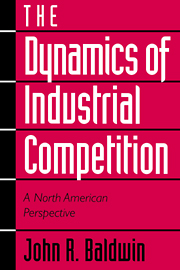Book contents
- Frontmatter
- Contents
- preface
- Acknowledgements
- 1 The dynamics of competition
- 2 Greenfield entry and closedown exit
- 3 Entry, exit, and the merger process
- 4 The rise and fall of incumbents
- 5 Patterns of large- and small-firm mobility
- 6 Plant turnover in Canada and the United States
- 7 Measures of market structure and the intensity of competition
- 8 The relationship between mobility and concentration
- 9 Turnover and productivity growth
- 10 Merger success
- 11 Turnover in domestic and foreign enterprises
- 12 Industry efficiency and firm turnover in the Canadian manufacturing sector
- 13 Firm turnover and profitability
- 14 Modelling entry
- 15 Conclusion
- Appendix A Measuring firm turnover – methodology
- Appendix B Definition of concentration and mobility measures
- Notes
- References
- Author index
- Subject index
14 - Modelling entry
Published online by Cambridge University Press: 30 March 2010
- Frontmatter
- Contents
- preface
- Acknowledgements
- 1 The dynamics of competition
- 2 Greenfield entry and closedown exit
- 3 Entry, exit, and the merger process
- 4 The rise and fall of incumbents
- 5 Patterns of large- and small-firm mobility
- 6 Plant turnover in Canada and the United States
- 7 Measures of market structure and the intensity of competition
- 8 The relationship between mobility and concentration
- 9 Turnover and productivity growth
- 10 Merger success
- 11 Turnover in domestic and foreign enterprises
- 12 Industry efficiency and firm turnover in the Canadian manufacturing sector
- 13 Firm turnover and profitability
- 14 Modelling entry
- 15 Conclusion
- Appendix A Measuring firm turnover – methodology
- Appendix B Definition of concentration and mobility measures
- Notes
- References
- Author index
- Subject index
Summary
A structural determinant of market conduct and performance that is at least as important as any other is the condition of entry to individual industries.
Joe Bain (1968: 251)Introduction
Traditional models of the equilibrating process for markets stress the role of entry. Positive economic profit results in entry.
The process of entry continues until each firm earns zero economic profit. Within this theoretical framework, it is precisely excess economic profit that attracts new entry. The field of industrial organization has modified the conventional microeconomic view by stressing that adjustments to disequilibrium are not smooth and that the path of adjustment in turn affects the level of equilibrium profits in different industries. Certain factors such as advertising, research and development, and concentration have been hypothesized to act as entry barriers and to perpetuate profit differences across industries.
Since the seminal works of Bain (1956) and Modigliani (1958), the economic profession has focused on the existence of entry barriers. Empirical work on entry has generally used models that are based on the disequilibrium view that entry occurs mainly in response to excess profits. The most widely used models are the “limit-price” models of entry in which it is posited that the profit level above which entry is attracted differs industry by industry and is a function of entry barriers. Incumbents can set higher prices thereby generating higher profits in industries with high barriers without attracting entry. The level of price above which entry occurs is the limit price. Determinants of entry and their implications for market structure and performance have traditionally been estimated by employing these types of models.
- Type
- Chapter
- Information
- The Dynamics of Industrial CompetitionA North American Perspective, pp. 360 - 379Publisher: Cambridge University PressPrint publication year: 1995



